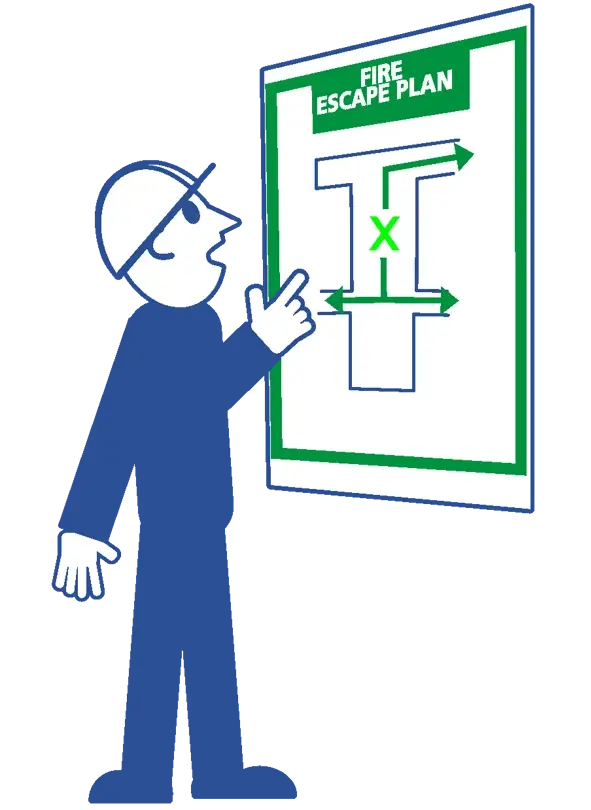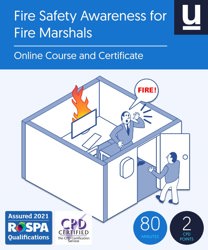A fire marshal, also known as a fire warden, is an appointed person in an organisation. A fire marshal has several responsibilities. The main one is to assist with fire evacuations and safety procedures to ensure they are carried out safely.
The other duties of a fire warden involve raising the alarm in the event of a fire, calling the emergency services, guiding people towards the designated assembly points, and taking a roll call.
The Fire Marshal's Role
The role of a fire warden also includes checking fire safety measures and emergency procedures. These measures include emergency exits, fire doors, fire alarms, fire safety signs, emergency lighting, arranging for electrical equipment to be PAT tested, checking fire extinguishers to ensure they are in working order, and assisting with fire drills.
If you would like more information on the role and responsibilities of a fire marshal, you can click here to see our dedicated article on the topic.
Determine the risk of fire.
The first thing to consider when calculating how many fire marshals a business requires is the level of risk that a workplace poses. This should already have been determined as part of the fire risk assessment process.
Fire Safety Risk Levels
There are three levels of fire risk: low, medium, and high.
Workplaces with a low fire risk are those with:
- Few highly flammable materials present.
- Few or no heat sources that could ignite a fire.
- No high-risk groups are present, such as elderly or disabled people.
- Traditionally built and well-maintained premises.
- Clear and safe escape routes.
- Well-maintained and appropriate fire safety measures, such as fire doors and suitably placed firefighting equipment.
Notably, only a few workplaces, such as small shops and offices, will likely fall under this category.
Workplaces with a medium fire risk are those with:
- Some highly combustible materials are present, such as paper and cardboard.
- Some heat sources could ignite a fire.
- Several high-risk individuals present.
- Suitable measures that should be implemented to confine or slow the spread of a fire and allow time to evacuate.
- Well-maintained and appropriate fire safety measures.
Most workplaces will fall into this category.
Workplaces with a high fire risk are those with:
- Significant amounts of highly flammable materials are present.
- Multiple heat sources, such as cooking or welding equipment, could ignite a fire.
- A layout that will slow down the speed of an evacuation.
- Construction that allows for fire to spread quickly.
- Many high-risk individuals present.
The workplaces under this category typically deal with fire and flammable materials (such as restaurants) or those that house vulnerable people (such as hospitals and care homes).
Other workplace fire safety factors
Alongside the level of risk that a workplace poses, several additional factors should be considered when determining the number of fire marshals a business requires. Think about the size of the premises and the number of staff. Factors include:
- The number of floors in the building—there must be at least one fire marshal for each floor.
- The number of people in the building and the level of risk will determine how many fire marshals are required. Typically, a low-risk workplace requires one fire marshal per 50 people, a medium-risk workplace requires 1 per 20, and a high-risk workplace requires 1 per 15.
- Holidays and sickness: Additional fire marshals should be available to cover sickness, holidays, and other absences.
- The number of shifts that need to be covered: there must be enough fire marshals to cover each shift fully, if applicable.
Calculating the number of fire marshals required
Let's look at an example workplace to explore how to calculate the number of fire wardens or marshals. A business requires a small office over two floors. This office employs 40 people, one of whom is hard of hearing.
The level of risk in this workplace is medium.
This is because there are highly flammable materials such as cardboard boxes and paper documentation, but there are very few sources of heat that could ignite a fire, as there is only a small staff kitchen on the ground floor. The office also has a large amount of open space, making searches and safe evacuations easier, and a clear emergency evacuation plan.
In this example, the office should appoint at least five fire marshals:
- Two to cover the number of people in the building (1 per 20), with one marshal on each floor.
- One to help the high-risk member of staff who is hard of hearing.
- Two to cover holidays, sickness, and other absences.
The specific number of fire marshals that a workplace requires will vary depending on a range of factors, including, but not limited to, those discussed in this article. For complex workplaces or those in which there is any doubt about the number of fire marshals required, we recommend you contact the local fire and rescue service for further advice.
Training on Fire Safety and Fire Marshal Online Course
Commodious offers two fire safety awareness training courses: one designed for all staff and the other is a specialised fire warden training. These courses are a great way of ensuring that a workforce is adequately trained in fire safety and understands how to act in the event of an emergency. For more information on these courses, use the links below:




